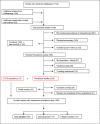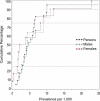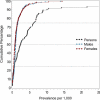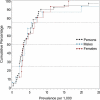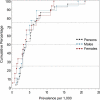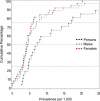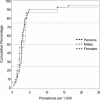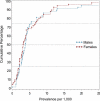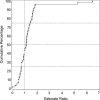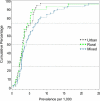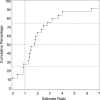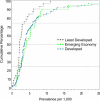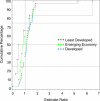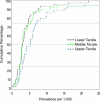A systematic review of the prevalence of schizophrenia - PubMed (original) (raw)
Review
A systematic review of the prevalence of schizophrenia
Sukanta Saha et al. PLoS Med. 2005 May.
Abstract
Background: Understanding the prevalence of schizophrenia has important implications for both health service planning and risk factor epidemiology. The aims of this review are to systematically identify and collate studies describing the prevalence of schizophrenia, to summarize the findings of these studies, and to explore selected factors that may influence prevalence estimates.
Methods and findings: Studies with original data related to the prevalence of schizophrenia (published 1965-2002) were identified via searching electronic databases, reviewing citations, and writing to authors. These studies were divided into "core" studies, "migrant" studies, and studies based on "other special groups." Between- and within-study filters were applied in order to identify discrete prevalence estimates. Cumulative plots of prevalence estimates were made and the distributions described when the underlying estimates were sorted according to prevalence type (point, period, lifetime, and lifetime morbid risk). Based on combined prevalence estimates, the influence of selected key variables was examined (sex, urbanicity, migrant status, country economic index, and study quality). A total of 1,721 prevalence estimates from 188 studies were identified. These estimates were drawn from 46 countries, and were based on an estimated 154,140 potentially overlapping prevalent cases. We identified 132 core studies, 15 migrant studies, and 41 studies based on other special groups. The median values per 1,000 persons (10%-90% quantiles) for the distributions for point, period, lifetime, and lifetime morbid risk were 4.6 (1.9-10.0), 3.3 (1.3-8.2), 4.0 (1.6-12.1), and 7.2 (3.1-27.1), respectively. Based on combined prevalence estimates, we found no significant difference (a) between males and females, or (b) between urban, rural, and mixed sites. The prevalence of schizophrenia in migrants was higher compared to native-born individuals: the migrant-to-native-born ratio median (10%-90% quantile) was 1.8 (0.9-6.4). When sites were grouped by economic status, prevalence estimates from "least developed" countries were significantly lower than those from both "emerging" and "developed" sites (p = 0.04). Studies that scored higher on a quality score had significantly higher prevalence estimates (p = 0.02).
Conclusions: There is a wealth of data about the prevalence of schizophrenia. These gradients, and the variability found in prevalence estimate distributions, can provide direction for future hypothesis-driven research.
Conflict of interest statement
Competing Interests: The authors have declared that no competing interests exist.
Figures
Figure 1. Flow Diagram (Selection Strategy) of Included Studies
Double asterisk indicates exclusion categories (number studies excluded in parentheses). Double asterisk indicates numbers that are not mutually exclusive. A few studies provided rates for more than one group (11 studies provided data for both core and migrant [n = 3] or both core and other special groups [n = 8]; details in Results). LOTE, language other than English.
Figure 2. Cumulative Plots of the Point Prevalence Estimates per 1,000 by Sex
Figure 7. Cumulative Plots of the Inpatient-Census-Derived Prevalence Estimates per 1,000 by Sex
Figure 3. Cumulative Plots of the Period Prevalence Estimates per 1,000 by Sex
Figure 4. Cumulative Plots of the Lifetime Prevalence Estimates per 1,000 by Sex
Figure 5. Cumulative Plots of the LMR Estimates per 1,000 by Sex
Figure 6. Cumulative Plots of the NOS Prevalence Estimates per 1,000 by Sex
Figure 8. Cumulative Plots of Combined Prevalence Estimates per 1,000 by Sex
Figure 9. Cumulative Plots of the Male:Female Prevalence Estimate Ratio of Schizophrenia
Figure 10. Cumulative Plots of Combined Prevalence Estimates per 1,000 for Persons by Urbanicity
Figure 11. Cumulative Plots of the Migrant:Native-Born Prevalence Estimate Ratio for Persons
Figure 12. Cumulative Plots of the Combined Prevalence Estimates per 1,000 for Persons by Economic Status of Country
Figure 13. Cumulative Plots of the Male:Female Prevalence Estimate Ratio of Schizophrenia by Economic Status of Country
Figure 14. Cumulative Plots of Combined Prevalence Estimates per 1,000 for Persons by Tercile of Quality Score
Comment in
- The global prevalence of schizophrenia.
Bhugra D. Bhugra D. PLoS Med. 2005 May;2(5):e151; quiz e175. doi: 10.1371/journal.pmed.0020151. Epub 2005 May 31. PLoS Med. 2005. PMID: 15916460 Free PMC article. - Secondary schizophrenia.
Hambidge D. Hambidge D. PLoS Med. 2005 Sep;2(9):e279; author reply e300. doi: 10.1371/journal.pmed.0020279. Epub 2005 Sep 27. PLoS Med. 2005. PMID: 16173833 Free PMC article. No abstract available.
Similar articles
- A systematic review of the incidence of schizophrenia: the distribution of rates and the influence of sex, urbanicity, migrant status and methodology.
McGrath J, Saha S, Welham J, El Saadi O, MacCauley C, Chant D. McGrath J, et al. BMC Med. 2004 Apr 28;2:13. doi: 10.1186/1741-7015-2-13. BMC Med. 2004. PMID: 15115547 Free PMC article. Review. - Folic acid supplementation and malaria susceptibility and severity among people taking antifolate antimalarial drugs in endemic areas.
Crider K, Williams J, Qi YP, Gutman J, Yeung L, Mai C, Finkelstain J, Mehta S, Pons-Duran C, Menéndez C, Moraleda C, Rogers L, Daniels K, Green P. Crider K, et al. Cochrane Database Syst Rev. 2022 Feb 1;2(2022):CD014217. doi: 10.1002/14651858.CD014217. Cochrane Database Syst Rev. 2022. PMID: 36321557 Free PMC article. - Schizophrenia: a concise overview of incidence, prevalence, and mortality.
McGrath J, Saha S, Chant D, Welham J. McGrath J, et al. Epidemiol Rev. 2008;30:67-76. doi: 10.1093/epirev/mxn001. Epub 2008 May 14. Epidemiol Rev. 2008. PMID: 18480098 Review. - Incidence of schizophrenia does not vary with economic status of the country: evidence from a systematic review.
Saha S, Welham J, Chant D, McGrath J. Saha S, et al. Soc Psychiatry Psychiatr Epidemiol. 2006 May;41(5):338-40. doi: 10.1007/s00127-006-0041-7. Epub 2006 Mar 6. Soc Psychiatry Psychiatr Epidemiol. 2006. PMID: 16520883 Review. - The prevalence of schizophrenia in mainland China: evidence from epidemiological surveys.
Long J, Huang G, Liang W, Liang B, Chen Q, Xie J, Jiang J, Su L. Long J, et al. Acta Psychiatr Scand. 2014 Oct;130(4):244-56. doi: 10.1111/acps.12296. Epub 2014 Jun 11. Acta Psychiatr Scand. 2014. PMID: 24916190
Cited by
- Treatment of clozapine-associated weight gain: a systematic review.
Whitney Z, Procyshyn RM, Fredrikson DH, Barr AM. Whitney Z, et al. Eur J Clin Pharmacol. 2015 Apr;71(4):389-401. doi: 10.1007/s00228-015-1807-1. Epub 2015 Jan 28. Eur J Clin Pharmacol. 2015. PMID: 25627831 Review. - Genetics of schizophrenia (Review).
Trifu SC, Kohn B, Vlasie A, Patrichi BE. Trifu SC, et al. Exp Ther Med. 2020 Oct;20(4):3462-3468. doi: 10.3892/etm.2020.8973. Epub 2020 Jul 7. Exp Ther Med. 2020. PMID: 32905096 Free PMC article. Review. - Polygenic risk scores for schizophrenia and major depression are associated with socio-economic indicators of adversity in two British community samples.
Machlitt-Northen S, Keers R, Munroe PB, Howard DM, Pluess M. Machlitt-Northen S, et al. Transl Psychiatry. 2022 Nov 14;12(1):477. doi: 10.1038/s41398-022-02247-8. Transl Psychiatry. 2022. PMID: 36376270 Free PMC article. - DISC1 and Striatal Volume: A Potential Risk Phenotype For mental Illness.
Chakravarty MM, Felsky D, Tampakeras M, Lerch JP, Mulsant BH, Kennedy JL, Voineskos AN. Chakravarty MM, et al. Front Psychiatry. 2012 Jun 19;3:57. doi: 10.3389/fpsyt.2012.00057. eCollection 2012. Front Psychiatry. 2012. PMID: 22723785 Free PMC article. - Altered asymmetries of resting-state MRI in the left thalamus of first-episode schizophrenia.
Liu S, Guo Z, Cao H, Li H, Hu X, Cheng L, Li J, Liu R, Xu Y. Liu S, et al. Chronic Dis Transl Med. 2022 Aug 22;8(3):207-217. doi: 10.1002/cdt3.41. eCollection 2022 Sep. Chronic Dis Transl Med. 2022. PMID: 36161199 Free PMC article.
References
- Murray CJ, Lopez AD, editors. The global burden of disease: A comprehensive assessment of mortality and disability from diseases, injuries, and risk factors in 1990 and projected to 2020. Boston: Harvard School of Public Health; 1996. 990 pp.
- American Psychiatric Association. Diagnostic and statistical manual of mental disorders: DSM-IV, 4th ed. Washington (DC): American Psychiatric Association; 1994. 886 pp.
- Jablensky A. In: Schizophrenia: The epidemiological horizon. Hirsch SR, Weinberger DR, editors. Schizophrenia Oxford: Blackwell Science; 2003. pp. 203–231.
- Eaton WW. Epidemiology of schizophrenia. Epidemiol Rev. 1985;7:105–126. - PubMed
Publication types
MeSH terms
LinkOut - more resources
Full Text Sources
Medical
